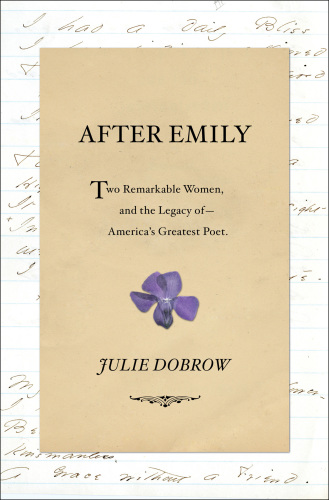
After Emily
Two Remarkable Women and the Legacy of America's Greatest Poet
کتاب های مرتبط
- اطلاعات
- نقد و بررسی
- دیدگاه کاربران
نقد و بررسی

May 28, 2018
Tufts University professor Dobrow chronicles the lives of two of Emily Dickinson’s earliest champions and editors, the mother-daughter team of Mabel Loomis Todd and Millicent Todd Bingham, shining a light on how they shaped “the contours of poetry as we know it today.” Mabel, an author, was also the longtime lover of Dickinson’s brother, Austin, bringing her into conflict with Austin’s wife, Sue, and Emily’s sister, Lavinia. These feuds frequently stalled publication of Dickinson’s work and, as Mabel neared the end of her life, she implored Millicent to continue working on the poet’s as-yet unpublished output. Dobrow authoritatively traces the tortuous editorial and publication process that first brought Dickinson’s work to public attention, and sensitively explores her subjects’ interior lives, showing how Mabel suffered from being the other woman in Austin’s life and how Millicent struggled growing up in her charismatic mother’s shadow. Quotes from Mabel’s diary demonstrate her intuitive understanding of Dickinson’s greatness, such as when she declared that the poems “seemed to open the door into a wider universe.” Impeccably researched using more than 700 boxes of the Todds’ personal documents, Dobrow’s narrative gives a fascinating glimpse into the lives of two tireless advocates for Dickinson’s work, demonstrating how poet and editors alike were “all women pushing up against the boundaries of their times.”

July 15, 2018
An elegant recovery of the two women without whom "Because I could not stop for Death" likely wouldn't be required reading for American high school students.During her lifetime, Emily Dickinson (1830-1886) didn't publish much, but after she died, her brother's mistress took up the cause of Dickinson's verse. Mabel Loomis Todd is one of the stock characters of the Dickinson story. Dobrow (Director, Center for Interdisciplinary Studies/Tufts Univ.) spent years in the massive Todd archives--Yale's Sterling Library holds more than 700 boxes of diaries, journals, and notes about psychiatric sessions--in order to recount, with sympathy and nuance, Todd's near-obsession with editing Dickinson, securing a publisher, and publicizing the poet on the lecture circuit. While telling Todd's story, the author sensitively explores the (much-criticized) editorial choices Todd made and the question of who was responsible for the "legend" of Emily-the-recluse-in-white. Less well known than Todd is her daughter, Millicent Todd Bingham, who completes Dobrow's twinned biography. Bingham grew up immersed in her mother's obsession with Dickinson: "Initiation into the vagaries of Emily's handwriting is one of the earliest rites I can recall," she once said. As an adult, she took over the work, publishing yet-unseen poems and letters and delving into arguments about copyright and archive battles. (Dobrow manages to make wrangling between university libraries fascinating.) The author reduces neither woman to her devotion to Dickinson. She attends to their professional accomplishments, world travels, marriages, and passion for conservation. The book, then, is about the Belle of Amherst, but it is also about being a working woman, a mother, and a daughter.All entries in the voluminous literature on Dickinson are controversial--some will bristle at such a positive depiction of Todd or suggest that some of Dickinson's relatives deserve more charity or credit. One hopes the controversy will simply bring increased attention to Dobrow's fresh, remarkable account.
COPYRIGHT(2018) Kirkus Reviews, ALL RIGHTS RESERVED.

August 1, 2018
(1830-86) would not be known as America's Greatest Poet. Here, Dobrow (Ctr. for Interdisciplinary Studies, Tufts Univ.) tells the women's stories. As a family friend of the Dickinsons in Amherst, MA, Mabel was introduced to Emily's poetry, which she found quite powerful. Complicating matters, Mabel began a decade-long affair with Emily's also-married brother, Austin. Following Emily's death, Mabel worked hard to get her poetry into print and succeeded, which led to long-lasting personal and legal feuds with Emily's heirs. Millicent sought her own path, free from her mother's entanglements, including the poet's oeuvre, but her own intellectual interests as a geographer soon played second fiddle to Emily and her legacy when a cache of hidden manuscripts was revealed. VERDICT The biographical material related to Emily Dickinson's legacy is the work's driving force, but Dobrow's skillful account of Mabel's and Millicent's lives makes this page-turner a must-read for the poet's most ardent fans.--Brian Flota, James Madison Univ., Harrisonburg, VA
Copyright 2018 Library Journal, LLC Used with permission.

Starred review from October 1, 2018
Scholarly arguments about how Mabel Loomis Todd and her daughter, Millicent Todd Bingham, handled Emily Dickinson's work during their years of editing and compiling the nearly 1800 poems discovered after Dickinson's death will continue. But thanks to Tufts University professor Dobrow's astonishing new research, readers gain a better understanding of their efforts. Mabel began organizing, transcribing, editing, and publishing Emily's poems at the request of Emily's sister, Lavinia, and became devoted to the cause. After Mabel's death, Millicent continued, publishing Emily's previously unseen poems and tackling copyright issues. Dobrow's intimate portrait of these artistically talented and intelligent women, based largely on their extensive, detailed diaries and correspondence, reveals fallible women who painstakingly attempted to share an extraordinary poet's vision. What is more remarkable is how they balanced that work and the demands of marriage and family, handled the corset-tight gender restrictions of their time, dealt with male input regarding their editorial approach, navigated delicate and shifting alliances within the Dickinson family, and opened public minds to Emily's singular poetic vision, often through intuitive and savvy marketing. Hopefully, Dobrow's chronicle will draw readers back to Dickinson, whom Dobrow rightly names as America's greatest poet.(Reprinted with permission of Booklist, copyright 2018, American Library Association.)

























دیدگاه کاربران